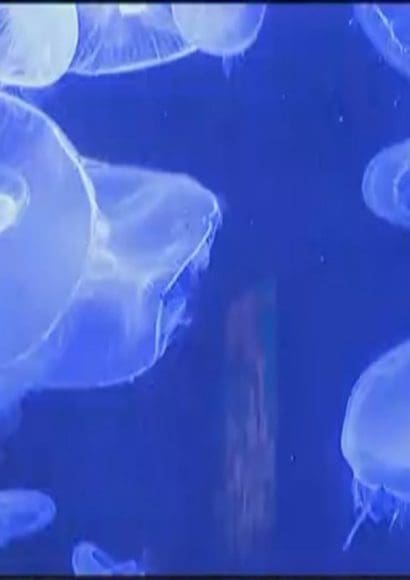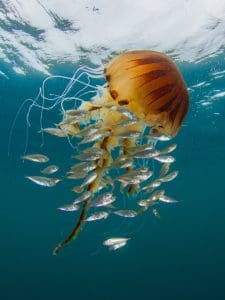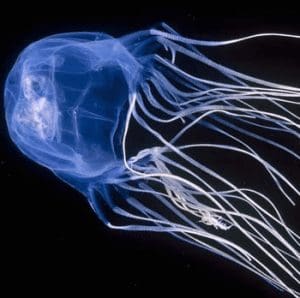
Jellyfish, with their enchanting yet treacherous presence, have long captured the fascination of marine enthusiasts and curious wanderers alike. Drifting gracefully through the depths of the ocean, these gelatinous creatures boast an ethereal beauty that belies the potential danger they possess.
In this article, we embark on a captivating journey to explore the captivating world of jellyfish, delving into their mesmerizing allure and the hazards they pose to both humans and marine life. Join us as we unravel the secrets of these mysterious sea dwellers, revealing the delicate balance between their undeniable allure and the essential caution we must exercise in their presence. Welcome to the realm of jellyfish: beauty and danger in the sea.
Contents
The Beauty of Jellyfish.🐟
Jellyfish, also known as sea jellies, are mesmerizing marine creatures that belong to the phylum Cnidaria. Found in oceans all around the world, they are renowned for their captivating appearance and delicate movements. With their translucent bodies and trailing tentacles, jellyfish possess an otherworldly allure that has inspired awe and curiosity for centuries.
Description of the Fascinating Appearance of Jellyfish:
Jellyfish exhibit a unique and ethereal appearance that sets them apart from most other marine creatures. Their bell-shaped, gelatinous bodies pulsate rhythmically as they propel themselves through the water, creating an entrancing spectacle. The sight of their gently undulating umbrella-like bells and long, trailing tentacles is both mesmerizing and haunting, evoking a sense of wonder at the marvels of the ocean.
Explanation of their Varied Colors and Forms that Make them Unique and Attractive:
One of the most captivating features of jellyfish is their stunning array of colors and forms. Some species display vibrant hues of pink, blue, purple, and even bioluminescent glows, while others appear transparent, showcasing their internal structures and mesmerizing patterns. These diverse colors and shapes add to their allure, making each species a distinct work of art in the vast canvas of the ocean.
Mention of their Role in Popular Culture, Art, and Mythology:
Beyond their scientific significance, jellyfish have deeply influenced human culture and art. Their graceful movements have inspired artists, poets, and writers, becoming a symbol of tranquility and harmony with nature. In various mythologies, jellyfish have been depicted as celestial beings or messengers of the sea, entwined with tales of love, loss, and transformation. Moreover, their presence in popular culture, from movies to fashion, serves as a testament to their enduring appeal and fascination among people of all ages.
The Life of Jellyfish.🐟
General Information: Jellyfish, graceful inhabitants of the ocean, belong to the phylum Cnidaria and are found in a wide range of marine environments worldwide. These captivating creatures boast a unique life cycle and survival strategies that have enabled them to thrive in the vast and often unpredictable waters of the world’s oceans.
Description of their Life Cycle and Natural Habitat in the Oceans:
The life cycle of a jellyfish is a fascinating journey that comprises several distinct stages. It typically begins as a free-swimming larva, known as a planula, which attaches itself to a suitable surface, such as rocks or algae, to become a polyp. The polyp then undergoes a process of asexual reproduction, giving rise to a stack of saucer-shaped buds called ephyrae. These ephyrae eventually break off and metamorphose into fully grown jellyfish, ready to navigate the open waters.
Explanation of their Movement and Feeding Mechanism, Highlighting their Survival Tactics:
Jellyfish exhibit a mesmerizing mode of locomotion, known as pulsation. By rhythmically contracting and relaxing their bell-shaped bodies, they push water behind them, propelling themselves forward. Their elegant movements are an essential part of their survival, allowing them to navigate currents and seek out food sources.
As carnivorous creatures, jellyfish are opportunistic feeders, preying on plankton, small fish, and other marine organisms. Their tentacles, equipped with specialized cells called cnidocytes, deliver a paralyzing sting to immobilize their prey. Once captured, the tentacles guide the food to the jellyfish’s mouth, located at the center of its bell. This unique feeding mechanism sustains their energy needs and ensures their survival in the competitive marine ecosystem.
Mention of Some Notable Jellyfish Species:
Among the vast array of jellyfish species, several stand out due to their remarkable characteristics. For instance, the “Aurelia aurita” or moon jellyfish, with its translucent bell and delicate, moon-like markings, is one of the most commonly encountered species. Another notable species is the “Chironex fleckeri,” also known as the box jellyfish, which possesses a potent venom and is considered one of the most venomous marine creatures, posing a significant threat to humans.
The Importance of Jellyfish in the Marine Ecosystem.
Jellyfish play a significant role in the intricate web of marine life, contributing to the balance and functioning of the ocean’s ecosystems. Despite their seemingly delicate appearance, these enigmatic creatures exert a considerable influence on the marine environment.
Explanation of their Ecological Role as Predators and Prey:
Jellyfish participate as both predators and prey in the marine ecosystem. As predators, they actively hunt and consume various small marine organisms, including plankton, fish eggs, and larvae. Their voracious appetite for plankton, in particular, helps regulate plankton populations, preventing an unchecked increase that could lead to imbalances in the food chain.
Conversely, jellyfish also serve as a crucial prey species for many marine predators. Animals such as sea turtles, certain fish species, and some seabirds rely on jellyfish as a vital food source, making them an integral part of the trophic interactions in the ocean.
Discussion on How Jellyfish Affect the Balance of Marine Ecosystems:
Jellyfish populations have the potential to influence the balance of marine ecosystems, often in complex and dynamic ways. Their population fluctuations can be influenced by various factors, including temperature, nutrient availability, and changes in the ocean’s food web.
Mention of their Contribution to the Marine Food Chain and Support to Other Species:
Jellyfish are vital players in the marine food chain, connecting different trophic levels. As mentioned earlier, they feed on plankton, helping to control planktonic populations and preventing excessive blooms that could lead to harmful algal blooms (HABs). By consuming plankton, jellyfish play a role in nutrient cycling, releasing nutrients back into the water as waste, which can be further utilized by other marine organisms.
Furthermore, jellyfish provide sustenance to various marine predators. For example, leatherback sea turtles, which are known to feed almost exclusively on jellyfish, depend on these gelatinous creatures for their survival. Additionally, jellyfish can serve as a critical food source for certain commercially valuable fish species, contributing to fisheries and the livelihoods of coastal communities.
The Danger of Jellyfish.🐟
While jellyfish are undeniably captivating, it is essential to recognize that some species can pose a significant danger to humans and other marine creatures. Understanding the risks associated with jellyfish encounters is crucial for ensuring safety in coastal and oceanic environments.
Description of Poisonous Jellyfish and their Stings:
Certain jellyfish species possess venomous tentacles armed with specialized cells called nematocysts, designed to inject toxins into their prey and potential threats. Among the most notorious venomous jellyfish are the box jellyfish (Chironex fleckeri) and the Portuguese man o’ war (Physalia physalis). These creatures are equipped with potent stinging cells that can cause severe reactions in those who come into contact with them.
Explanation of the Effects of Jellyfish Stings on Humans and Other Marine Creatures:
When a human or another creature comes into contact with the stinging tentacles of venomous jellyfish, the nematocysts are triggered, releasing venom into the victim’s skin. The effects of jellyfish stings can range from mild irritation and discomfort to more severe and potentially life-threatening reactions.
In humans, the symptoms of a jellyfish sting may include intense pain, redness, itching, swelling, and a rash around the affected area. In severe cases, stings from highly venomous jellyfish can lead to systemic reactions, such as difficulty breathing, rapid heartbeat, and even cardiac arrest, necessitating immediate medical attention.
Tips for Avoiding Jellyfish Stings and How to Respond if Stung:
Preventing jellyfish stings is the best approach to stay safe while enjoying the ocean. Here are some tips to avoid stings:
- Stay informed: Be aware of jellyfish warnings and advisories issued by local authorities before heading to the beach.
- Wear protective clothing: If jellyfish are present in the area, consider wearing a rash guard or wetsuit to minimize skin exposure.
- Swim in designated areas: Stick to designated swimming areas where lifeguards can keep an eye on potential jellyfish presence.
- Avoid touching jellyfish: Never touch jellyfish, dead or alive, as their nematocysts can still be active and cause stings.
If stung by a jellyfish, it is essential to act promptly:
- Rinse with vinegar: If available, rinse the affected area with vinegar to neutralize the nematocysts and reduce further venom release.
- Rinse with saltwater: If vinegar is unavailable, rinse with saltwater, avoiding freshwater, as it may trigger more venom release.
- Remove tentacles: Use a pair of tweezers or the edge of a credit card to carefully remove any tentacle fragments from the skin.
- Seek medical attention: Even for mild stings, it is advisable to seek medical attention, as some reactions may not be immediately apparent.
Myths and Realities about Jellyfish.🐟
General Information: Jellyfish have long been shrouded in myths and misconceptions, leading to both fear and fascination. However, it is essential to separate fact from fiction when it comes to these enigmatic creatures to better understand their true nature and how to interact with them safely in the marine environment.
Debunking Misconceptions about Jellyfish:
One common myth is that all jellyfish are highly venomous and pose an immediate threat to humans. In reality, while some species do have potent stings, not all jellyfish are dangerous. There are numerous harmless species that lack the powerful toxins found in their venomous counterparts.
Another misconception is that jellyfish actively seek out and attack humans. In truth, jellyfish are generally passive drifters, at the mercy of ocean currents, and they only sting when they come into contact with something that triggers their nematocysts (stinging cells), whether it be prey or an unwitting swimmer.
Explanation of Why Some Jellyfish are Not as Dangerous as Believed:
As mentioned earlier, not all jellyfish have venomous tentacles. Many species have mild or non-toxic stings that may cause minor irritation at most. Additionally, some jellyfish have developed other defense mechanisms, such as camouflage or transparent bodies, to avoid predators, but they do not rely on venomous stings for protection.
Clarification on How to Coexist Safely with Jellyfish in the Sea:
To coexist safely with jellyfish in the ocean, it is essential to adopt certain practices and precautions:
- Be observant: Stay aware of any jellyfish warnings or advisories issued by local authorities and be cautious when swimming in areas with known jellyfish presence.
- Respect their space: Avoid touching or attempting to handle jellyfish, as this can lead to stings. Keep a safe distance and allow them to drift undisturbed.
- Wear protective gear: Consider wearing a wetsuit or rash guard while swimming to reduce skin exposure, especially in areas prone to jellyfish blooms.
- Know first aid: Familiarize yourself with proper first aid measures for jellyfish stings, such as using vinegar to neutralize nematocysts and seeking medical attention if necessary.
Conservation and Protection of Jellyfish.🐟
In conclusion, the conservation and protection of jellyfish are vital for maintaining the health and biodiversity of our oceans. While some species may pose a danger to humans, the majority play crucial roles as predators and prey, contributing to the intricate web of marine life. Dispelling misconceptions and understanding their true nature can foster coexistence with jellyfish safely and responsibly.
As ocean lovers and stewards of the environment, it is our responsibility to support initiatives that promote the conservation of jellyfish and their habitats. By reducing pollution, minimizing plastic waste, and adopting sustainable fishing practices, we can create a healthier marine environment for all marine creatures, including jellyfish.


